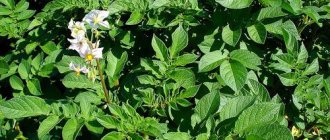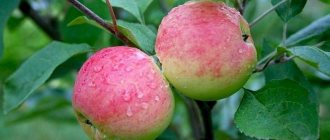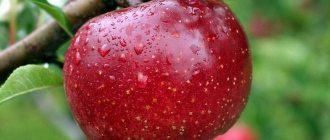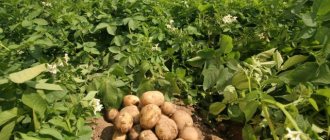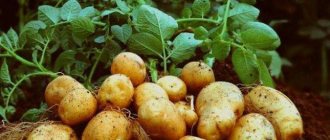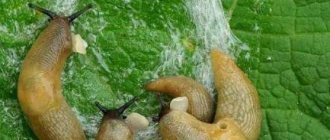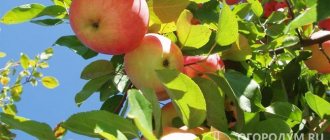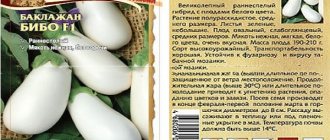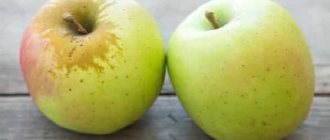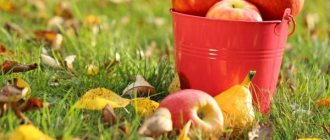Apple tree Gala Mast
The apple tree is an early winter tree. Has an attractive appearance. The tree itself grows of medium height, the branches fall down. The weight of the fruit can reach up to 200 grams. They have a bright appearance, with a pronounced red blush. The pulp is very tender, light yellow. "Gala" is an excellent pollinator for other varieties. Harvesting should be done in late September-early October. Apples can be stored for a long time. In my cellar, apples lie quietly until February-March. At the same time, you must sort through the apples, setting aside spoiled fruits. Advantages of the variety: early fruiting, taste and appearance, ease of care, long shelf life. Disadvantages: does not tolerate low frosts, slows down the growth of the tree after the start of fruiting.
The Gala Mast apple tree is a variety of the Gala apple tree. Only the fruits themselves are larger than those of the Gala variety. They weigh on average 150-170 grams, and the color of apples when fully ripe is bright, blurry red. It blooms in mid-May and produces a lot of fruit. To get large ones, a little thinning is required. If this is not done, the frequency of high yields may become lower. These apples ripen at the end of September. It is preferable to harvest immediately, because the apples can crack right on the branches. This variety stores quite well. At a constant temperature in the basement or refrigerator, apples can be preserved for six months. Susceptible to several diseases. Most often - powdery mildew, so you need to treat the trees to get a good harvest. Our winters are not too cold, about 15 degrees below zero, the trees survive them calmly, although we wrap the trunks.
I have a dwarf rootstock, so my apple tree of the Gala Mast variety began to bear fruit already in the 3rd year, which, of course, could not but make me happy. The harvest, of course, was not great in the first year, but these isolated fruits also pleased me. By the way, in the first harvest they grew as much as 40 kg. It's a late variety, I pick the last apples in November. The variety does not need pollinators, it is self-pollinating, but given my experience, I can recommend having pollinators nearby, they clearly improve the yield of the tree. Treatment against powdery mildew is necessary; the apple tree has low immunity to it. This is perhaps the only disadvantage of the Gala Mast variety. Otherwise, I am completely satisfied with it: a rich harvest already for 8-10 years of life, every year it increases.
Planting and caring for an apple tree
Gala grows well and produces large yields in many countries; in our country it can be grown in the steppe and forest-steppe parts of the country in areas with a temperate climate. The soil in the southern forest-steppe regions is fertile, has a large humus layer, and its composition is suitable for growing fruit trees.
Seedlings of this variety take root better when planted in autumn. Calculate the planting time based on local climatic conditions. The young tree will have time to take root if it is planted about a month before the first frost.
Dig a hole in advance; it should stand for at least two weeks before planting. The diameter of the hole is 1 m, the depth is 1 m. When digging a hole, remove the top fertile layer and add 2-3 buckets of humus and several glasses of ash.
When planting, the seedling should be tied to a peg driven in the center of the hole; this will prevent mechanical damage to the trunk and branches. It is good to shed the tree trunk circle with water; the seedling should receive a sufficient amount of moisture when planting.
Watering
The peculiarity of the variety is that it does not like excess moisture, so plan watering in accordance with weather conditions. Young trees should be watered every week for the first three years. Mature trees that have entered the fruiting season should be watered if the weather is dry and the top layer of soil is dry.
Ovary control
A necessary agrotechnical technique when growing apple trees of the Gala and Gala Mast varieties is the regulation of fruiting. It is used to produce large, one-dimensional fruits. Work to remove excess ovaries is carried out in the spring, leaving only the amount that will not lead to depletion of the tree.
If the excess ovaries are not removed, the apple tree will be overloaded with fruits, and as a result will form fewer flower buds. In this case, next summer the harvest will be small and the apple tree will rest. When removing excess ovaries, remember that the distance between the remaining fruits should be at least 15 centimeters.
Disease Prevention
You can prevent diseases and repel pests with the help of preventive measures:
- In early spring, before the snow melts, whiten the trunk and large skeletal branches of the lower tier.
- In the spring, while the buds have not yet blossomed, thoroughly spray the entire crown with a 3% solution of Bordeaux mixture.
- After flowering, repeat the treatment, but use copper oxychloride.
Trimming
Carry out the first pruning the next year after planting.
It is important not to be late and do it before the buds open. It is necessary to cut off the top of the central shoot and shorten the branches, this will initiate the growth of new shoots
In the future, every year in early spring, trim last year’s growth by a third of its length. This not only improves the appearance of the crown, but also leads to normalization of the yield and makes annual fruiting possible.
Garden pests and their control
The main pests that reduce the yield of apple trees are:
- weevil;
- codling moth;
- leaf roller.
The weevil eats the flowers and thereby reduces the yield. It is necessary to fight it as early as possible, before the females begin laying eggs. The first and easiest way is to lay a cloth under the tree, shake it by the trunk, and destroy the fallen beetles. The second method is to treat wood with Calypso. It is safe for bees and can be used without harming them.
The codling moth eats apples from the inside and spoils the harvest. In the spring you need to arrange trapping belts. You can use burlap soaked in whey for them. Spraying trees with fresh infusion of wormwood helps a lot; the smell repels insects.
The leaf roller attacks leaves and buds. Tree leaves can be sprayed with infusions of tomato tops or wormwood leaves; Lufox is a good remedy for leaf rollers.
The time spent on growing Gala apple trees will quickly pay off with decent harvests of tasty and beautiful fruits.
Reviews from gardeners
Grigory, 45 years old, Krasnodar region
Our Gala tree is not tall and has been producing fragrant fruits for more than seven years. Under their weight, the branches sag and the crown becomes weeping. We have to put up supports and shorten branches pointing inward. The harvest is regular, with an average yield of approximately 50 kg. We collect fruit at the end of September and store it in the basement in wooden boxes until March. In early November, they resemble sweet caramel with a pleasant sourness. The pulp is juicy and the appearance is beautiful. Caring for the tree is not difficult, but in the fall, in order to prevent scab, I spray the branches and trunk with a solution of ammonium nitrate (10%). Last year, the codling moth ate the insides of apples and ruined almost the entire harvest. In the spring I installed hunting belts made of burlap soaked in whey. Spraying with a fresh infusion of wormwood helped a lot; its smell perfectly repels insect pests.
Ekaterina, 38 years old, Stavropol
After planting a two-year-old seedling, we do not take special care of the tree. In the fall, we dig up the soil near the tree trunk, apply potassium-phosphorus fertilizers to increase winter hardiness, and in early spring we cut off last year’s growth by a third of its length. This not only improves the appearance of the crown, but also leads to normalization of the yield, making annual fruiting possible. We remove ripe fruits in early October, because they hold tightly to the branches and do not fall off. We collect so much fruit from one tree that we have enough to eat and make preparations. They lie well, we feast on them almost until the end of January. The taste is sour-sweet with a refreshing light anise aroma. The tree did not suffer from serious diseases in all ten years; scab appeared only once, and that was in an abnormally rainy summer.
Ivan, 39 years old, Rostov region
12 years ago we planted apple trees in the garden. Of the autumn varieties we chose Gala Royal. Constantly produces crops, more than 60 kilograms annually. I noticed that the more abundantly it bears fruit, the smaller the apples are in size. To obtain large and one-dimensional fruits, in the spring I remove some of the ovaries so that the distance between the remaining fruits is at least 10-15 centimeters. If this procedure is not done, the apple tree will be overloaded as a result, will form fewer flower buds next summer and will produce virtually no harvest. Ripe fruits look appetizing, covered with a continuous bright crimson blush. They taste juicy, sweet and sour, but they do not have a caramel-nut aroma, like a real Gala. After collection, they are stored for about six months. We eat with pleasure with the whole family almost all winter.
Diseases and pests
The Lada variety has an average degree of resistance to scab: only the leaves are affected, and the fruits remain intact.
Scab is an infection caused by a fungus.
It spreads first with light spots, and then they can become covered with a brown coating and grow over the area.
This unpleasant disease is curable, but you also need to know about preventive measures: monitor pruning, fertilizing (do not overdo it with nitrogen-containing fertilizers), try to plant in elevated areas.
As soon as you notice that scab has begun to affect the leaves, they must be immediately removed and destroyed.
Fallen leaves should be composted each fall to prevent the spread of spores. The soil must be dug up and the lawn treated with ammonium nitrate solution.
If this method does not work, you will have to resort to using chemicals. One option that can help in trouble is the drug "Skor".
It is diluted with water in a ratio of one to ten, and the tree begins to be sprayed with this mixture in early spring.
The second stage is the use of 4% copper oxychloride or copper sulfate: spraying is carried out after flowering.
An equally serious problem that you may encounter when growing an apple tree is pests.
They can significantly spoil not only the harvest, but also the health of the apple tree.
Chemicals come into play to combat them: copper sulfate, iron sulfate, chlorophos, Bordeaux mixture and more.
It is advisable that when spraying the air temperature is not lower than three degrees Celsius.
It is necessary to apply the preparations before the fruits ripen so that the chemicals do not penetrate into the fruits. The vapors of these drugs are not dangerous to humans, so they are quite suitable for use in personal gardens.
In order to get rid of insects that overwinter in the bark of an apple tree, you can apply a set of preventive and therapeutic measures:
- Whitewashing the trunk;
- Cleaning the bark;
- Treatment of tree wounds;
- Pruning branches before the beginning of the growing season.
From folk remedies: wood ash, which fights well against aphids and caterpillars.
The Lada variety has many advantages: the taste of the fruit, its versatility, and transportability. The trees are frost resistant.
The apple tree has high yields, despite the small size of the fruits. One of the disadvantages is the instability of the leaves to scab.
Watch a video on how to properly prepare lime whitewash and whitewash fruit trees.
Description of the variety
Autumn apple tree variety of New Zealand selection, obtained in 1962. Since the mid-1970s, it has been tested in Ukraine, and since 1993 it has been zoned in the steppe zone. In 2014, it was included in the State Register of Russia and zoned in the North Caucasus region. Industrial cultivation of Gala apples in Russia is concentrated in Crimea and Kuban. Occasionally found in homestead and country gardens in the southern regions of the Middle Zone.
The tree is medium-sized with a wide-oval, medium-dense crown. Skeletal branches depart from the trunk at an angle of 45-75°, fruiting occurs on ringlets, fruit twigs and the ends of annual shoots.
Gala bears fruit on ringlets, fruit twigs and the ends of annual shoots
Winter hardiness in its region is average. The variety has high immunity to powdery mildew, medium immunity to scab and zero immunity to European cancer.
It blooms in the mid-late period (late May - early June), has good pollen viability - 73-89%.
The pollinators for the variety in the growing region are apple tree varieties:
- Kate;
- Elstar;
- James Grieve;
- Idared;
- Red Delicious.
On vigorous rootstocks it begins to bear fruit 6-7 years after planting. The Gala apple tree on a dwarf rootstock will bear its first harvest in 3-4 years. While the apple trees are young (up to 10 years), they bear fruit annually and moderately. An adult tree can bear up to 55-80 kilograms of fruit. When overloaded, the fruits become smaller and fruiting periodicity is observed.
The fruits are one-dimensional, round or round-conical with slight ribbing at the top. The average weight is 130 grams, the maximum is 145 grams. They have a basic color of dense and thin skin of yellow or greenish-yellow color with a striped, blurry, orange-red blush on almost the entire surface of the apple. The pulp is crispy, juicy, dense, and has a light yellow color. The taste is excellent, sweet and sour. Tasting score: 4.6 points.
Apples of the Gala variety have a basic color of dense and thin skin of yellow or greenish-yellow color with a striped, blurry, orange-red blush on almost the entire surface of the apple
Apples reach ripeness in mid-September, and are ready for consumption in November. Shelf life in a cool place is up to 60-80 days. At a temperature of 0-5 °C they are stored for 5-6 months. Purpose: for fresh consumption and juice production. Transportability is average.
Advantages of the variety:
- Excellent dessert taste of apples.
- Versatility of use.
- High yield.
- Precociousness.
- Immunity to powdery mildew.
Disadvantages of the variety:
- Insufficient winter hardiness and limited growing region.
- Low immunity to scab.
- Lack of immunity to European apple tree canker.
- Shrinking of fruits when overloaded with harvest.
Popular varieties and types of Gala apple trees
The Gala apple tree has about twenty species and clones, but the sources do not contain detailed descriptions and characteristics of each of them. Let's look at some of the most common ones.
Gala Mast
Recognized as the best of the clones. It has larger fruits (160-220 grams) of a rich red-ruby color. Its increased resistance to powdery mildew is also noted.
The Gala Mast apple tree has larger fruits (160-220 grams) of a rich red-ruby color
Gala Royal
This species is distinguished by a more spectacular red-raspberry color, a conical shape of apples and a slightly larger weight (150 grams). Distributed in the USA and Europe.
Gala Royal apples are distinguished by a more spectacular red-raspberry color.
Gala Shniga
Italian clone of the Gala Royal variety. Ripening at the end of August - first half of September. Storage in the refrigerator for 4-5 months. Relatively frost-resistant. Highly susceptible to scab, bark and wood diseases. Powdery mildew is mildly affected. The crown is well branched. The fruits are very beautiful, excellent presentation. The color is yellow with a pink side and a dark red striped blush on most of the surface of the apple. The taste is very sweet.
Gala Shniga - Italian clone of the Gala Royal apple tree
Reviews from gardeners
I have two Gala apple trees growing in my garden. I don’t have any special knowledge of growing apple trees, I take care of them as best I can, but the trees bear fruit well. There are enough apples, we even sell some of them, we have regular customers who, just like us, love Gala for her taste.
From one Gala tree we collect so many apples that we have enough to just eat and make preparations. They lie well, we feast on them for a long time. Caring for an apple tree is not difficult, it takes little time.
The Gala variety is the best variety for industrial gardens and private plots. Apples can be used to make cider, wine, jams, and compotes. An excellent variety for breeding.
The Gala apple tree is one of the most popular autumn varieties of foreign selection. Due to a number of advantages, it is in great demand in industrial gardening in Europe, South and North America. The variety is also successfully grown by domestic farmers and summer residents in regions with temperate and warm climates.
The characteristic features of the variety are given in the table:
| Parameter | Characteristic |
| Culture | Apple tree (Malus domestica Borkh.) |
| Variety | "Gala" |
| Tree height | About 3.5 meters |
| Precociousness | High |
| Maturation period | Autumn (late September – early October) |
| Consumption/storage period | Late autumn (November – February) |
| Type of fruiting | Mixed |
| Fruit weight | Average 130 g |
| Productivity | High – up to 80 kg from one mature tree per season; regular |
| Shape and color | The apples are one-dimensional: medium-sized, round or round-conical. The skin is dry, thin, but dense. The color of the skin is uneven: yellow or greenish-yellow with a striped blurred blush of an orange-red hue, almost on the entire surface |
| Fruit pulp | Light yellow, dense, juicy |
| Tasting assessment (taste qualities) | 4.6 points (out of 5) – taste sourish-sweet |
| Purpose | Dessert (universal) |
| Sustainability | Average winter hardiness. High immunity to powdery mildew; average resistance to scab; heavily affected by European cancer |
| Year of inclusion in the register of Ukraine | 1993 |
| Recommended growing regions | Forest-steppe and steppe zones |
| Year of inclusion in the State Register of the Russian Federation | 2014 |
| Regions of admission | North Caucasian (6) |
| Originators | Institute of Horticulture of the Ukrainian Agrarian Academy of Sciences (Kiev), Institute of Irrigated Horticulture (Melitopol, Ukraine), JSC "Crimean Fruit Company" (Republic of Crimea) |
additional characteristics
Peculiarities
And why such fame and popularity:
Apple variety Gala Shniga.
- Productivity is high. It is not for nothing that it is included in the top ten varieties from New Zealand to the Moscow region.
- It begins to bear fruit early.
- There are no problems with transportation and keeping quality of fruits.
What complaints do gardeners and specialists have:
- Many people want larger fruits. There are always enough skeptics.
- And winter hardiness is higher. To expand the cultivation areas of this variety. And gardeners with a not very favorable climate should have this variety in their garden.
- The vigorous growth of young trees slows down when they begin to bear fruit.
- And the apples are getting smaller.
- And it may be the reason for the occurrence of periodicity of fruiting. The harvest will not be annual.
Favorable areas for cultivation
- If we take into account their industrial cultivation in Europe and America. And in China.
- But the best for them are the forest-steppe and steppe zones. The soil and humidity are suitable. Poland, Ukraine, Russia.
- He also masters the subtropics.
Tree height
- Already at an advanced age it can even reach 5 meters.
- The variety itself is medium-sized.
- It is also sometimes called vigorous.
- Consider the rootstocks. On a semi-dwarf tree, even an adult tree does not exceed 3.5 m.
Crown width
- The crown is like a flattened ball, unevenly spreading.
- They also compare it with a wide-pyramidal one.
- And its width corresponds to the selected rootstock.
Productivity
- Some are impressed - 50-80 kg per tree. Even 90 kg.
- And for some, 15 is enough.
- And you can regulate it (both the flowers and the ovary). If you want bigger apples. After all, the variety has a certain tendency to overload.
- Fruits every year.
- Older apple trees may exhibit periodicity and reduced yield.
Tasting assessment
Over 4.5 out of five. They also give 4.6-4.7.
And be sure to pay attention to:
And a little information about the deliciousness and health benefits of Gala apples:
- Vitamin A - for clear eyes.
- Ascorbic acid will boost your immunity.
- Everyone needs iron.
- One of the main varieties for dietary nutrition.
Disease resistance
Who is not sick at all? There is no such. But everything is different. What hardening and stability.
So it is with the Gala varieties:
- Resistance to scab is somewhere average.
- To powdery mildew and European cancer – high.
- There are bacterial cancer lesions.
Help trees resist disease with a set of disease prevention measures.
Lifespan of a tree
How many apples will please you depends on the selected rootstock
And they don’t pay special attention to this. But there are no 100-year-old apple trees yet. Due to young age
Because of his young age.
And it already exists and is bearing fruit. This only convinces me of the correctness of the chosen variety - Gala Mast.
The dessert taste is incomparable. But he cannot lie down for long. But for the New Year we have these apples on the table. And not from the store, but our own.
Consumer qualities of fruits
The fruits are uniform, medium in size, weighing 130 g (115-145 g), maximum up to 170 g. The shape of the apples is round or round-conical. The skin is dry, thin, but dense. The color when removed is yellow or greenish-yellow with striped watercolor stains of an orange-red hue, covering almost the entire surface. The light yellow flesh is juicy and dense. It tastes sweet and sour with nutty notes and caramel aroma. Professional tasting assessments of taste – 4.6 points (out of 5). In reviews, many summer residents call the taste “aniseed,” refreshing, caramel-nutty with a refined aroma.
According to the ripening period, the variety belongs to the autumn variety (late September - early October), and according to the period of consumption - to the late autumn variety (November). Until ripeness, the apples are firmly held on the tree. The external attractiveness and amazing taste of the fruit do not decrease during transportation and long-term storage for 2-3 months under normal conditions, and in the refrigerator - until February. Considering its high marketability, transportability and shelf life, the variety is recommended primarily for commercial cultivation and industrial processing.
Advantages and disadvantages
Most summer residents and specialists consider the dessert taste of the fruit and the possibility of its universal use to be the most valuable qualities of the variety. In addition, “Gala” is distinguished by:
- high and regular yield;
- immunity to powdery mildew.
Problem areas of the Gala apple tree are:
- dependence on other pollinating varieties;
- insufficiently high winter hardiness;
- tendency for fruits to become smaller when trees are overloaded with crops;
- susceptibility to European cancer;
- average resistance to scab (especially in rainy years).
Since the variety is self-sterile, it requires the presence of other pollinating apple trees that bloom at similar times, for example, “Idared”, “Elstar”, “James Grieve”, “Red Delicious”.
Planting a tree
Before you start planting trees on your property, it is important to choose a suitable location. Moreover, for two trees at once - the Gala variety itself and its pollinator
It is important to look for a sunny place for the apple tree, 5 meters from a fence or any building - apple trees really love such areas. The south side is optimal.
Planting holes are prepared either in the fall or in the spring, depending on the chosen season. In the spring, a hole is prepared to plant an apple tree in the fall, and in the fall, on the contrary, for spring planting. There is no need to dig a large hole. The maximum depth is 60 m, and the diameter is no more than 1 m.
It is recommended to mark the place with a peg so as not to accidentally lose sight.
We recommend reading our other articles
- Growing tomatoes in a greenhouse
- Minorca chickens
- Peach variety Golden Moscow
- Pepper Swallow
Gala apples are not difficult to grow. A tree of this variety is an unpretentious species, but still requires compliance with certain planting conditions and high-quality care. It is best to plant the tree in loam or sandy loam. The soil must be fertilized. The location chosen is sunny, spacious, with a low level of groundwater.
Interesting!
With a bountiful harvest, Gala apples will be medium in size. If the tree does not produce a lot of apples (age, crop rationing), they will grow quite large and very sweet.
The Gala variety tree should be planted in early autumn so that it has time to take root before the cold weather. If autumn frosts may occur unexpectedly, it is advisable to plant in the spring. About a month before planting, you need to dig up the area and dig a hole for the seedling. If pests and diseases often appear on the site, then it is better to disinfect the soil. To do this, simply water the soil with a 3% solution of copper sulfate.
The Gala variety tree should be planted in early autumn.
Planting soil is prepared separately. For one deep hole measuring a meter in diameter and the same depth, you need 1 bucket of peat and the same amount of compost. You can also add about 500 g of wood ash and 130 g of potassium sulfate. The rest is the earth obtained by digging the hole. If the soil is clayey, sand is also added. When planting several trees, the distance between the holes for them is maintained at 3 meters.
Important!
Only a day after planting, you can mulch the tree trunk area with compost, peat or humus, in a layer of 8 cm.
Planting seedlings is an important stage during which the foundation for the yield and health of the tree is laid. Planting a Gala apple tree seedling is no different from planting seedlings of other varieties. The main thing is to adhere to the rules of agricultural technology when planting a bush in a permanent place.
Landing time
The optimal time for planting in spring is considered to be the period from the first days of April to the beginning of May. In autumn, seedlings are planted 20-25 days before the onset of autumn frosts. The seedling must have time to take root in a new place before frost hits.
Selecting a location
The first thing you need to remember when planting the Gala variety on your site is light. The hybrid prefers to grow in open sunny areas away from darkness. If you plant the plant in the shade, the yield will decrease, and the apple tree itself will grow poorly. Due to the lack of sunlight, the number of buds decreases, which in turn leads to poor flowering and the formation of ovaries.
Gala prefers to grow on loamy, sandy loam soils or black soil. It is recommended to give preference to elevated areas where melt water will not accumulate in the spring. The Gala apple tree prefers to grow in dry soils without excess moisture.
Before purchasing a seedling, it is carefully inspected. The seedling should not show signs of damage, dry branches, stains or traces of insects
It is also worth paying attention to the root system. The roots should be elastic and strong, not broken
The trunk is straight, with dense bark.
Planting process
The process of planting a seedling takes place in several stages. Stages of planting a Gala apple tree:
- Dig up the soil, dig a hole to a depth of 1 m.
- Add mineral fertilizers for growth, rotted compost and wood ash.
- Mix the fertilizers with the soil and leave the hole as is for 2-3 weeks.
- After 2-3 weeks, they begin to plant the seedling.
- Place the seedling in a hole, carefully straighten the roots and bury the seedling with soil.
- Compact the soil around the trunk.
- Water generously with warm water.
- Then drive a stake next to the seedling and tie the trunk to it.
Agrotechnics of cultivation
Seedlings of this apple tree variety should be planted in much the same way as other fruit trees. You just need to remember that the active growth of the Gala apple tree and its further fruiting depend on strict adherence to all the rules for planting young trees in the garden.
Complete cultivation technology (pruning, care, fertilizing, harvesting and other operations) - video
Selecting a site for planting
It is best to choose a place to plant this fruit tree on a small slope located in the southern or southeastern part of the garden plot, which should be protected from northern and northeastern winds by a fence or walls of buildings.
On a note!
The area for planting the Gala apple tree should be well illuminated by the sun's rays and also blown by a light draft.
The Gala apple tree variety prefers soils that are loose, chernozem, loamy or sandy loam with a neutral or slightly alkaline reaction.
Planting holes for these seedlings are dug at a distance of at least 3 m from other trees or buildings.
Apple tree Gala: description and characteristics of the variety
The Gala apple tree is very often grown in foreign countries. And oddly enough, it can be found in England, where the main variety is considered to be Golden Delicious, with which the Gala variety competes. In this area there are a large number of fields that are planted with these apple trees.
The variety is often used in industrial production, as it is not picky about climate conditions. The variety traveled from Holland to Russia on a very long and difficult path. It was bred by breeder J.H. Kidd in the 60s of the 20th century.
The apple tree got its name from the Greek woman Gala. Translated from French as holiday. Apple trees are planted on an industrial scale in Brazil and the USA.
The variety has the following subspecies:
- Red Gala;
- Red Royal;
- Gala Mast;
- Gala Galaxy and others;
Tree. Medium size, branches pointing down. They grow best in the forest steppe zone. But they can also adapt to subtropical climates. It is necessary to constantly adjust the number of ovaries so as not to overload the tree with apples.
For industrial purposes, the variety is grown in the USA, China and Europe. Countries such as Russia, Ukraine and Poland have ideal climate conditions for the variety. The tree can stretch up to 5 meters.
The variety can withstand up to -30 degrees. Gala apple trees are moderately resistant to scab. They have high protection against powdery sundew and European cancer. It is necessary to periodically carry out preventive maintenance to avoid pest attacks. The tree begins to bear fruit at the 5th year of life.
Foliage. Egg-shaped with a dark green point.
Flowers. Small, saucer-shaped, white in color. It can bear fruit on spears, ringlets and twigs. The plant begins to bloom at an average time. The apple tree has a lot of ovaries, some of them can be tidied up a little.
Fruit. Averaged with a specific gravity of about 150 grams. Apples have the shape of a rounded cone. They have a yellow-green color with an orange-red tint. The taste is sweet with sourness, the flesh is compacted and light yellowish. You can make preserves, jams, juices and other goodies.
You can collect up to 100 kg of apples from one tree. Mature apple trees may not bear fruit every year. Tasters rate the variety 4.5 points out of 5.0. The variety is classified as dietary. The fruit contains retinol, ascorbic acid and iron.
The fruits are well attached to the branches. If you store them in a cellar or basement, they will last about 3 months. But if you create suitable conditions, the shelf life can be extended to 6 months.
Rules for planting the Cameo variety
Before planting on a site, you should pay attention to several factors:
- soil condition and its fertility;
- ground water level;
- the growth strength of the trees themselves;
- their winter hardiness and drought resistance.
For an apple tree of this variety, a square with a side of 4 meters is enough (the trees are not very tall). Cameo depends on the temperature; it is recommended to plant it after it starts to get colder. The optimal temperature regime is from +10°C and below, but before the period of rest and wintering begins; This time usually falls in November.
It is better to prepare planting holes in early autumn. The top layer of soil, after clearing of weeds and bushes, is laid in one direction, and the layer of lower soil in the other. A protective cushion is subsequently formed from the top layer around the seedling.
The hole for the tree should be prepared and fertilized in advance. A universal option for any soil: 1 liter of wood ash, 1 bucket of humus and the same amount of compost. Before the planting process, a layer of drainage is added if the soil requires it. Fertilizers are laid out after drainage, then sprinkled with a small amount of soil (about 7 cm).
Important! Before planting a seedling, it is necessary to cover a layer of fertilizer with soil, otherwise the fragile roots may get burned, which will lead to the death of the tree.
Work progress during landing:
- The roots are carefully examined. Any dry, damaged or sore areas are removed. The edges are trimmed to the white core (no more than 1 cm).
- The tree is placed in a hole, straightening the root system, and carefully covered with soil from the top layer, compacting it regularly.
- After the planting hole is completely filled, a protective cushion is built around it from the remains of the earth.
- The tree is watered with 1-2 buckets of water, and the hole itself is mulched (dry soil, peat or fertilizer).
History of selection of the Gala variety
The variety received the right to a separate existence in New Zealand, and its progenitors were two popular varieties: Godin Delicious and Kids Orange. Today, the selection of Galovsky apples continues successfully and more than two dozen varieties are already known. The rapid spread across all continents was facilitated by the high productivity of the variety: Gala occupies the second position in terms of productivity among other varieties of apple crops.
In European countries and the USA, where Gala apples grow, they are very common. They appeared on Russian territory relatively recently - about 20 years ago. But even in such a short time for the spread of fruit trees, this variety managed to take root well in this part of Europe and demonstrates good productivity.
The country of origin of the Gala variety is New Zealand. The variety was developed in 1957 by crossing the Golden Delicious and Kidd's Orange Red varieties. The author of the variety is J. H. Kidd. After receiving a prototype, having assessed its not very outstanding external characteristics, the author begins to develop new hybrid species in order to improve quality.
With the advent of high-quality hybrids, varieties began to gain popularity in 1965 and are used in industrial-scale plantings in New Zealand and Europe, from where they are brought to Russia and Ukraine. However, in these countries the variety was regionalized only in 1993 and was not used on an industrial scale. By 2021, the variety has become widespread worldwide and is recognized as one of the best.
Adaptation in regions
The Gala variety has average frost resistance , so it is better not to plant it in areas where severe frosts . The risk that the tree will not survive the winter is too high.
So where do Gala apple trees grow?
The apple tree was originally bred in New Zealand, where winter temperatures are almost never below zero.
Tropical and subtropical forests predominate here.
Subsequently, the variety was improved, winter hardiness and overall endurance of the tree increased.
The optimal zones for the Gala variety at the moment are steppes and forest-steppes. But this is only in theory; in fact, the apple tree will feel good in any region where there are no harsh winters and severe swampiness.
